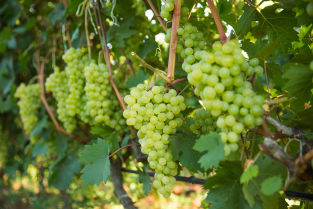The incredibly beautiful nature and favourable climatic conditions of Karabakh, which is considered a heartland of ancient culture, gave impetus to the development of viticulture and winemaking there. These traditions, with unshakable historical roots, combined with great development prospects, are sure to give the legendary Karabakh wines a new lease of life.
From historical roots... When talking about the history of viticulture and winemaking in the Karabakh region, it must be noted that during archaeological excavations, grape seeds and petrified clay jars dating back 3,500 years were discovered at the Uzarliktepe monument, near the city of Aghdam. According to historical sources, in 1913 there were 26,500 hectares of vineyards in 15 districts of Azerbaijan. In this period, one of the wine-alcohol trusts created during the nationalisation of farms after the First World War was the Karvin Union in Karabakh. This union laid the initial foundation for the future development of viticulture and winemaking in Karabakh.
via viticulture... In 1929-1931, about 80 native grape varieties were studied on the territory of Azerbaijan, and a certain number of the identified grapes were from the region of Aghdam. The history of viticulture in the Karabakh-Mil region, which is divided into three sub-zones, goes back thousands of years. Known for its production of dessert wines, grape juice and fresh grapes for local consumption, the region was home to a large number of table and specialised indigenous grape varieties: as well as Khindogni, Gara Ikeni, Gara Shire, Amiri, Marandi, Gara Gyoz, Gush Ureyi, Aghdam Gizil Uzumu, Zeynebi, and Dash Gararti grapes, and we can add grape varieties such as Aghdam Kechimemesi and Aghdam Khazarisi to this list.
Khindogni is a historical grape variety belonging to the Karabakh region. In the climate of Karabakh, high quality, full-bodied, well-coloured and pleasantly fresh table wines were made from Khindogni. The Gara lkeni variety is the most valuable specialised grape variety of Azerbaijan with black berries. The vines of this variety can be found in old vineyards and alleys in the regions of Ganja and Goygol, as well as Karabakh, in particular the region of Fuzuli.
and winery traditions... The famous Turkish scientist and geographer Evliya Chelebi wrote in his travelogue in the 17th century that high quality grapes were grown in Karabakh, as well as much more produce, including flavoured juices. Furthermore, the remains of petrified wine in a Shamakhi museum, found during archaeological excavations in a village of Gubadli District and dating to between the 5th and 7th centuries BC, prove that winemaking in Karabakh is an ancient area of activity.
In the second half of the 20th century, considerable work to develop viticulture was carried out in Azerbaijan. At that time, among the dark port dessert wines produced by Azerbaijani wineries, were wines such as those from Karabakh and Aghdam. Aghdam port is a historical drink popular in the USSR and even in Europe. What made this drink different from other port wines was that it had 8% sugar and 19% alcohol composition. Aghdam port wines were made of Bayan Shira and Rkatsiteli grape varieties. It should also be noted that Aghsu wine, an ancient product of Azerbaijan, was made from Madrasa, Khindogni and Tavkveri grape varieties, cultivated in Shamakhi, Karabakh and Shamkir.
culminating in a fresh impetus! Karabakh, freed from 30 years of occupation, is set to return to its past appearance in the coming years. Large-scale restoration works are being carried out in Karabakh, which suffered serious destruction. Many of these projects will restore the traditions of viticulture and winemaking that existed in Karabakh, with the aim of giving new life to the famous Karabakh wines.




